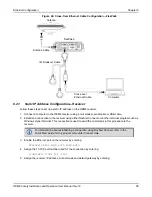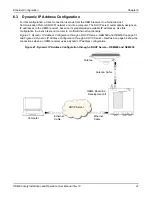
Built-In Status Tests
Chapter 5
OEM6 Family Installation and Operation User Manual Rev 12
84
5.5.4
Receiver Status Code
The receiver status word is included in the header of all logs. It has 32 bits that indicate certain receiver
conditions. If any of these conditions occur, a bit in the status word is set. Unlike the error word bits, the
receiver continues to operate, unless the priority mask for the bit has been set. The priority mask bit changes
the receiver status word into an error bit. Anything that results from an error bit becoming active also occurs if
a receiver status and its associated priority mask bits are set.
5.5.5
Auxiliary Status Codes
The auxiliary status codes are only in the RXSTATUS log. The three arrays that represent the auxiliary status
codes indicates the receiver state for information purposes only. The events represented by these bits
typically do not cause receiver performance degradation. The priority mask for the auxiliary codes does not
put the receiver into an error state. Setting a bit in the auxiliary priority mask results in the corresponding bit in
the receiver status code to be set if any masked auxiliary bit is set. Bit 31 of the receiver status word indicates
the condition of all masked bits in the auxiliary 1 status word. Likewise, bit 30 of the receiver status word
corresponds to the auxiliary 2 status word and bit 29 to the auxiliary 3 status word.
Refer also to the RXSTATUS log in the
OEM6 Family Firmware Reference Manual
(OM-20000129) for a
more detailed description.
5.5.6
Set and Clear Mask for all Status Code Arrays
The other two mask words in the status code arrays operate on the associated status word in the same way.
These mask words are used to configure the bits in the status word that result in a RXSTATUSEVENT log
broadcast. The set mask is used to turn logging on temporarily while the bit changes from the 0 to 1 state.
The clear mask is used to turn logging on temporarily while the bit changes from a 1 to a 0 state. Note the
error word does not have any associated mask words. Any bit set in the error word results in a
RXSTATUSEVENT log broadcast (unless unlogged).
Refer also to the RXSTATUS log in the
OEM6 Family Firmware Reference Manual
(OM-20000129) for a
more detailed description.
5.6
Status LED
The diagnostic LED provided on the OEM6 family cards blinks green on and off approximately once per
second to indicate normal operation.
Error bits and status bits that have been priority masked as errors cause the LED to flash a code in a binary
sequence. The binary sequence is a six flash (0.5 second on and 0.25 second off per flash) sequence
followed by a one second delay. The sequence repeats indefinitely. If there are more than one error or status
present, the lowest number appears as the flash code output. The codes are ordered to have the highest
priority condition output first.
The first flash in the six flash sequence indicates if the code that follows is an error bit or a status bit. Error
bits flash red and status bits flash yellow. The next five flashes are the binary number of the code (most
significant bit first). A red flash indicates a one and a yellow flash indicates a zero. For example, for an error
bit six, the binary number is 00110 so the output sequence is:
followed by a one second delay. The sequence repeats indefinitely until the receiver is reset.
0
Red
0.5
0.75 1.25
1.5
2.0
2.25 2.75
3.0
3.5
3.75 4.25
5.25
Yellow
Yellow
Yellow
Red
Red















































